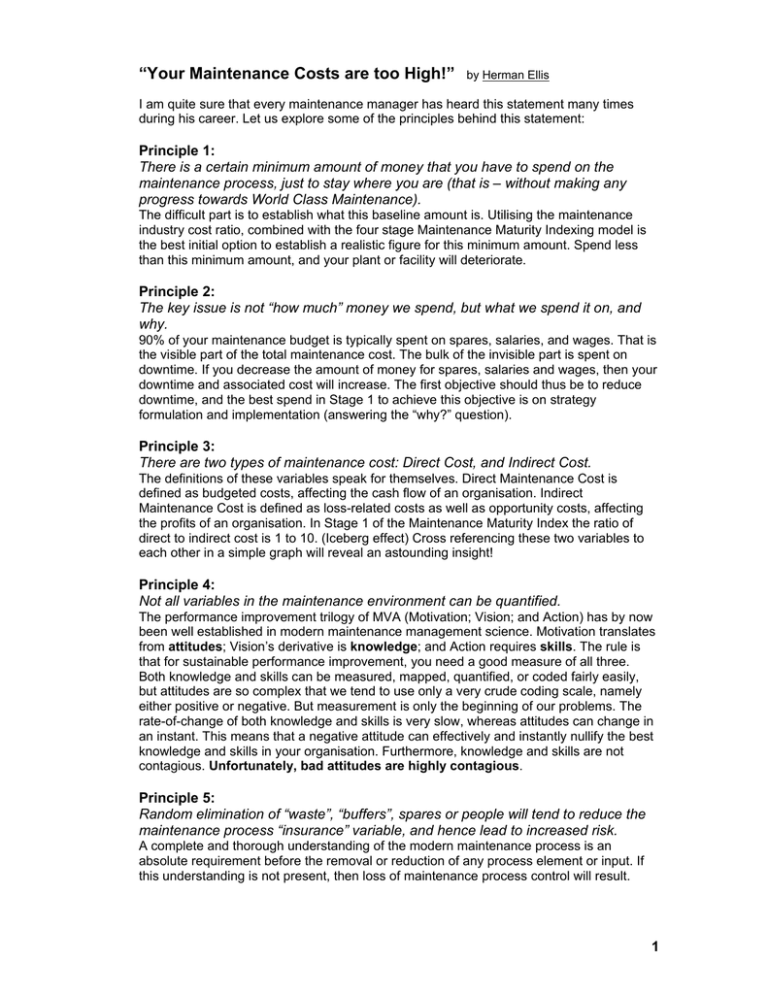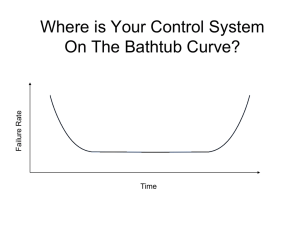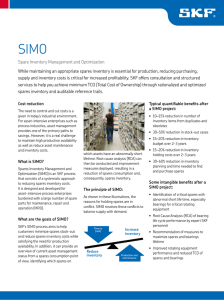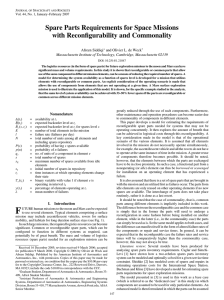“Your Maintenance Costs are too High!” by Herman Ellis
advertisement

“Your Maintenance Costs are too High!” by Herman Ellis I am quite sure that every maintenance manager has heard this statement many times during his career. Let us explore some of the principles behind this statement: Principle 1: There is a certain minimum amount of money that you have to spend on the maintenance process, just to stay where you are (that is – without making any progress towards World Class Maintenance). The difficult part is to establish what this baseline amount is. Utilising the maintenance industry cost ratio, combined with the four stage Maintenance Maturity Indexing model is the best initial option to establish a realistic figure for this minimum amount. Spend less than this minimum amount, and your plant or facility will deteriorate. Principle 2: The key issue is not “how much” money we spend, but what we spend it on, and why. 90% of your maintenance budget is typically spent on spares, salaries, and wages. That is the visible part of the total maintenance cost. The bulk of the invisible part is spent on downtime. If you decrease the amount of money for spares, salaries and wages, then your downtime and associated cost will increase. The first objective should thus be to reduce downtime, and the best spend in Stage 1 to achieve this objective is on strategy formulation and implementation (answering the “why?” question). Principle 3: There are two types of maintenance cost: Direct Cost, and Indirect Cost. The definitions of these variables speak for themselves. Direct Maintenance Cost is defined as budgeted costs, affecting the cash flow of an organisation. Indirect Maintenance Cost is defined as loss-related costs as well as opportunity costs, affecting the profits of an organisation. In Stage 1 of the Maintenance Maturity Index the ratio of direct to indirect cost is 1 to 10. (Iceberg effect) Cross referencing these two variables to each other in a simple graph will reveal an astounding insight! Principle 4: Not all variables in the maintenance environment can be quantified. The performance improvement trilogy of MVA (Motivation; Vision; and Action) has by now been well established in modern maintenance management science. Motivation translates from attitudes; Vision’s derivative is knowledge; and Action requires skills. The rule is that for sustainable performance improvement, you need a good measure of all three. Both knowledge and skills can be measured, mapped, quantified, or coded fairly easily, but attitudes are so complex that we tend to use only a very crude coding scale, namely either positive or negative. But measurement is only the beginning of our problems. The rate-of-change of both knowledge and skills is very slow, whereas attitudes can change in an instant. This means that a negative attitude can effectively and instantly nullify the best knowledge and skills in your organisation. Furthermore, knowledge and skills are not contagious. Unfortunately, bad attitudes are highly contagious. Principle 5: Random elimination of “waste”, “buffers”, spares or people will tend to reduce the maintenance process “insurance” variable, and hence lead to increased risk. A complete and thorough understanding of the modern maintenance process is an absolute requirement before the removal or reduction of any process element or input. If this understanding is not present, then loss of maintenance process control will result. 1 (Let’s reduce our maintenance budget by 10%, and see what happens!). Maintenance management is a developing science, not an issue to be gambled with. Principle 6: Cost represents only a very partial (financial) viewpoint of the whole issue, which is: “performance” or rather, “performance improvement”. The following issues are considered under the heading of performance improvement, only some of which are cost related. (These are not listed in order of importance): 1. Achieving more with less (process model). 2. Better results with the same inputs (process model). 3. Same result with reduced input (process model). 4. Eliminating waste (process model). 5. Speed gain (stratification model). 6. Quality gain (stratification model). 7. Doing the right things (effectiveness). 8. Doing things right (efficiency). 9. Solving problems permanently. (RCFA) 10. Pro-actively preventing problems from occurring in the first instance. (Planning efficiency) 11. Improved feedback loop signals (process model - Control efficiency). 12. Improved reference standards (process model - Control efficiency). 13. Sustainability (Control efficiency). 14. Adaptability (Creativity). 15. MVA 16. Maturity focus 17. Improved congruence between functional disciplines. 18. Sustainable empowerment initiative. Principle 7: A number of key variables in the maintenance environment are completely outside of effective control by the maintenance management. This implies limited control over their cost. The fact that maintenance cannot perform its work without full support and cooperation has been apparent for some time. 2 TABLE - I. IMPROVEMENT OF VITAL MAINTENANCE CONTROL ELEMENTS Degree of Primary Source Influence Maintenance Control Index for Priority Control Element Rating Control (%) Improvement 1 2 3 4 5 6 7 8 9 10 11 12 13 14 15 Labour Productivity Material Control Leadership Workload Organization Interdepartmental Relations Cost Data Performance Data PM Procedures Planning Scheduling Training Maintenance Engineering Technology Labour Practices 10 10 9 9 8 60 20 70 30 50 6.0 2.0 6.3 2.7 4.0 Maintenance Other Maintenance Other Other 8 20 1.6 Other 7 7 7 6 5 4 20 50 75 60 50 80 1.4 3.5 5.3 3.6 2.5 3.2 Other Other Maintenance Other Other Other 4 40 1.6 Other 3 2 90 20 2.7 0.4 Other Other Table I - Respondents rated the degree of direct maintenance influence over 15 vital control elements to establish priorities for improvement. Next, they rated the degree of control that maintenance had over each element. These two ratings were then multiplied to yield a control index. The results indicated maintenance could influence only 3 of 15 control elements (index of over 5.0). The remaining 12 elements could only be improved with support outside of maintenance. Reference: “Breakthrough Maintenance Strategy for the 21st Century” by Steven A. Tesdahl Andersen Consulting LLB & Paul D. Tomlingson - Paul D. Tomlingson Associates, Inc. With maintenance management being under continuous pressure to reduce cost – where do you think they are going to reduce cost? Only in the areas where they can! These may well be the last areas where they should reduce cost. Principle 8: Cost is not a stand-alone variable. It forms an inseparable part of the trilogy: CostRisk-Performance. Drive change any one of these and the other two will change as a result. Conclusion It is possible to double performance and reduce maintenance cost by 30%, simultaneously, by careful and selective application of these principles. Note by the author: Space does not allow for more than a very superficial listing of these principles with some notes. More information can be obtained from hermane@ megadial.com (22 April 2003) 3






